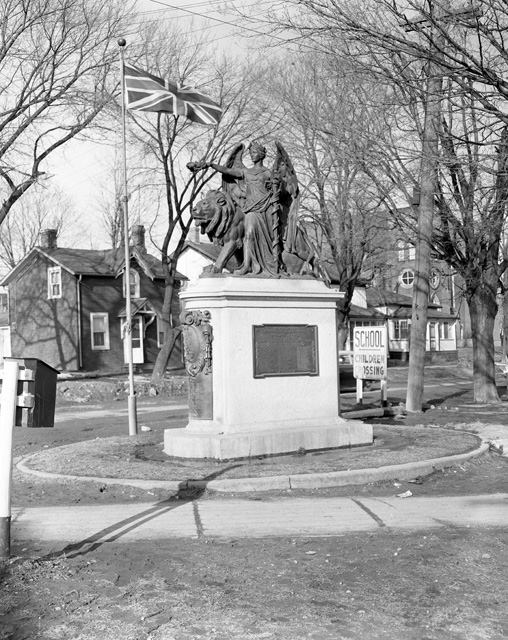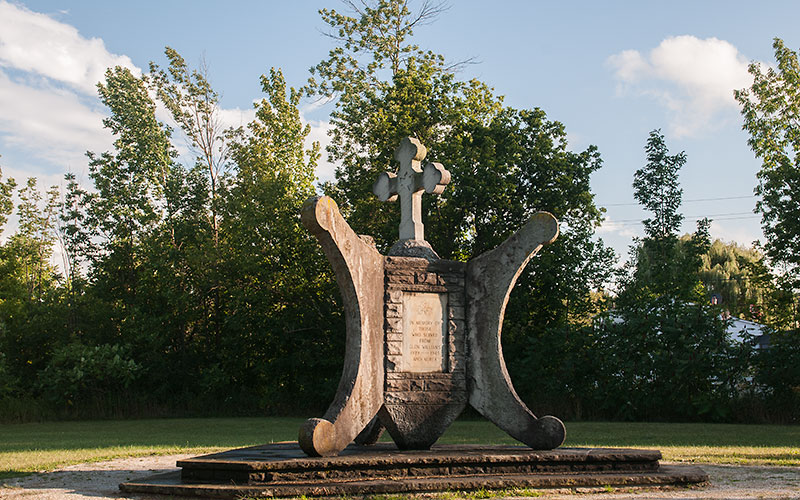Remembrance Park - Cenotaph (Georgetown and Glen Williams
Georgetown Remembrance Park - The original Memorial was erected in 1920, in memory of the local men who died in the Great War. It was later updated to include plaques dedicated to those lost in the Second World War and Korea. In 1960, the memorial was moved to its current location, and in 2000, received a major restoration and beautification program.
When looking at the Georgetown Cenotaph's honoured position in Remembrance Park, one can easily be tricked into thinking this was always its permanent home. But a cursory glance into its history reveals a compelling story. The Georgetown Cenotaph has had many lives in more than one location. It started out at the corner where Guelph and Main streets meet. No less a figure than General Arthur Currie, the mastermind of the Battle of Vimy Ridge, was on hand to unveil the memorial in 1924. Currie struck a balance between honouring the dead and abhorring war itself in his remarks at the inauguration. “War is a delusion and a lie for victory with the sword does not bring peace,” he told the gathered crowd in 1924. “Their names are written into the book of death, but their spirits will live in on, woven into the history of their country, for which they gave their lives.” There it remained until the 1960s. Mark Rowe, an archivist at the Esquesing Historical Society, says the location was chosen due to its high foot and car traffic.
“That was probably part of the thinking, placing it right there into the downtown, where all the visitors to the town would drive through,” he said.
However, car ownership rose meteorically by the '60s and the memorial’s location at a highway intersection become unsuitable.
“It meant that was an extremely busy corner and certainly not a place for reflection,” Rowe added.
The decision was made by the Town of Georgetown to move the cenotaph. A Town-owned patch of land was chosen for its new home. This parcel went on to become Remembrance Park. But the move did not go according to plan as the land was marshy. The truck, with the added weight of the memorial, got stuck in the muck. This forced the movers to install it right where their wheels sank in a rather awkward position. Its place of honour at that time was in the grass a few metres east of its current location, facing parallel to Charles Street. Brian “Ray” Clarke, second vice president of the Royal Canadian Legion’s Branch 120, moved to Canada from the United Kingdom in the '70s. He remembers being very confused by such an odd positioning at his first Canadian Remembrance Day.
“I questioned the members as to why it was in that position because it was so close to the fence line and it was in an obtuse position to the park itself,” Clarke said. When he was told the story of the truck getting bogged down in the marsh, he just laughed because he “couldn’t believe it.”
“It was just so funny to hear they had gone so far and then they were stuck,” Clarke said.
The cenotaph found its final place in the year 2000. The Dutch Canadian Remembrance Committee (DCRC), as well as many others who helped them, refurbished the memorial and moved it to its final location. Walkways, water features, flag poles, paving, a shade pavilion and many other flourishes were added to the final design of Remembrance Park at a cost of $270,000. Chairman of the DCRC Martin Boomsma, who died last month, was delighted with the work done on the project.
“It turned out beyond our expectations,” he told the Independent and Free Press at the time. “I never imagined the park would look this nice.”
FLT LT J. BLAIR, FLT LT C. BARBER, PTE J. CAMPBELL
PTE E. CORNISH, PTE J. COWAN, PTE H. FRANCIS,
PTE S. GODFREY, SERGT W.G. GRAINGER, PTE I. GREEN
PTE H. HICKEY, PTE P. KING, CPL W. KING, PTE J.E. KENNEDY
LIEUT E. LESLIE, PTE W. LOUD, PTE G. MASON, L.CPL. A.S. MINO
SGT OBS H. NELLE, PTE D. MCKENZIE, PTE W. PHILLIPS
PTE G.H. SLEIGHTHOLME, PTE G.H. SPIRES, PTE G.H. SPIRES
CPL W. KING, FLT LT C. SOMERVILLE, PTE S. STAWICKY
CPL. RON EDMUNDS
PTE. KEN NORTON
1939 - 1945
DVR. R. ALLEN, PTE. W.N. BALCH, PTE. C. BEAUMONT
FLT./SGT. L.H. BEAUMONT, PTE. R. BLAIR, LT. J. BOWMAN
PTE. J.C. BRADLEY, LAC. W. CARNEY, TPR. H. CONN
PTE. H. DAVIDSON, RFM J. DAVIS, PTE. E. DOYLE
PTE. H. DICKENSON, PTE. S. DICKENSON, PTE. C. DILLON
F/O. J. EVANS, PTE. J. HEMPHILL, PTE. E. HILTS
CPR. C. HYDE, PTE. J. JAMIESON, PTE. W. KAY
PTE. J. KENDALL, PTE. F. KIDD, PTE. G. LATIMER
P/O. J. LOUTH, FLT./SGT. S.A. MacLAREN
F/O. Wm. G. McLAUGHLIN, F/O. Wm. MURPHY
A/B. V. MILLAR, PTE. J. OLIVER, PTE. J. O'KANE
CPR. H. SHAW, PTE. H. SIMPSON, PTE. G. STOKES
F/O. C. SUTCLIFFE, SGT. H. TOST, PTE. R. WYLIE
PTE. W. WYLIE, LT. B.Z. ZIMMERMAN
Glen Williams Cenotaph - Built in 1971 by Gerald Inglis. The cross, which weighs around 200 lbs., was hand-cut by the pair from freestone at the Inglis farm on 10th Line. It has served as the gathering place for Remembrance Day services for locals ever since
When looking at the Georgetown Cenotaph's honoured position in Remembrance Park, one can easily be tricked into thinking this was always its permanent home. But a cursory glance into its history reveals a compelling story. The Georgetown Cenotaph has had many lives in more than one location. It started out at the corner where Guelph and Main streets meet. No less a figure than General Arthur Currie, the mastermind of the Battle of Vimy Ridge, was on hand to unveil the memorial in 1924. Currie struck a balance between honouring the dead and abhorring war itself in his remarks at the inauguration. “War is a delusion and a lie for victory with the sword does not bring peace,” he told the gathered crowd in 1924. “Their names are written into the book of death, but their spirits will live in on, woven into the history of their country, for which they gave their lives.” There it remained until the 1960s. Mark Rowe, an archivist at the Esquesing Historical Society, says the location was chosen due to its high foot and car traffic.
“That was probably part of the thinking, placing it right there into the downtown, where all the visitors to the town would drive through,” he said.
However, car ownership rose meteorically by the '60s and the memorial’s location at a highway intersection become unsuitable.
“It meant that was an extremely busy corner and certainly not a place for reflection,” Rowe added.
The decision was made by the Town of Georgetown to move the cenotaph. A Town-owned patch of land was chosen for its new home. This parcel went on to become Remembrance Park. But the move did not go according to plan as the land was marshy. The truck, with the added weight of the memorial, got stuck in the muck. This forced the movers to install it right where their wheels sank in a rather awkward position. Its place of honour at that time was in the grass a few metres east of its current location, facing parallel to Charles Street. Brian “Ray” Clarke, second vice president of the Royal Canadian Legion’s Branch 120, moved to Canada from the United Kingdom in the '70s. He remembers being very confused by such an odd positioning at his first Canadian Remembrance Day.
“I questioned the members as to why it was in that position because it was so close to the fence line and it was in an obtuse position to the park itself,” Clarke said. When he was told the story of the truck getting bogged down in the marsh, he just laughed because he “couldn’t believe it.”
“It was just so funny to hear they had gone so far and then they were stuck,” Clarke said.
The cenotaph found its final place in the year 2000. The Dutch Canadian Remembrance Committee (DCRC), as well as many others who helped them, refurbished the memorial and moved it to its final location. Walkways, water features, flag poles, paving, a shade pavilion and many other flourishes were added to the final design of Remembrance Park at a cost of $270,000. Chairman of the DCRC Martin Boomsma, who died last month, was delighted with the work done on the project.
“It turned out beyond our expectations,” he told the Independent and Free Press at the time. “I never imagined the park would look this nice.”
- IN MEMORY OF THOSE WHO FELL IN THE GREAT WAR
FLT LT J. BLAIR, FLT LT C. BARBER, PTE J. CAMPBELL
PTE E. CORNISH, PTE J. COWAN, PTE H. FRANCIS,
PTE S. GODFREY, SERGT W.G. GRAINGER, PTE I. GREEN
PTE H. HICKEY, PTE P. KING, CPL W. KING, PTE J.E. KENNEDY
LIEUT E. LESLIE, PTE W. LOUD, PTE G. MASON, L.CPL. A.S. MINO
SGT OBS H. NELLE, PTE D. MCKENZIE, PTE W. PHILLIPS
PTE G.H. SLEIGHTHOLME, PTE G.H. SPIRES, PTE G.H. SPIRES
CPL W. KING, FLT LT C. SOMERVILLE, PTE S. STAWICKY
- IN MEMORY OF THOSE WHO FELL IN THE KOREAN CONFLICT
CPL. RON EDMUNDS
PTE. KEN NORTON
- IN HONOUR OF THOSE WHO LAID DOWN THEIR LIVES SO THAT OTHERS MIGHT LIVE IN FREEDOM AND PEACE
- IN MEMORY OF THOSE WHO FELL IN THE
1939 - 1945
DVR. R. ALLEN, PTE. W.N. BALCH, PTE. C. BEAUMONT
FLT./SGT. L.H. BEAUMONT, PTE. R. BLAIR, LT. J. BOWMAN
PTE. J.C. BRADLEY, LAC. W. CARNEY, TPR. H. CONN
PTE. H. DAVIDSON, RFM J. DAVIS, PTE. E. DOYLE
PTE. H. DICKENSON, PTE. S. DICKENSON, PTE. C. DILLON
F/O. J. EVANS, PTE. J. HEMPHILL, PTE. E. HILTS
CPR. C. HYDE, PTE. J. JAMIESON, PTE. W. KAY
PTE. J. KENDALL, PTE. F. KIDD, PTE. G. LATIMER
P/O. J. LOUTH, FLT./SGT. S.A. MacLAREN
F/O. Wm. G. McLAUGHLIN, F/O. Wm. MURPHY
A/B. V. MILLAR, PTE. J. OLIVER, PTE. J. O'KANE
CPR. H. SHAW, PTE. H. SIMPSON, PTE. G. STOKES
F/O. C. SUTCLIFFE, SGT. H. TOST, PTE. R. WYLIE
PTE. W. WYLIE, LT. B.Z. ZIMMERMAN
Glen Williams Cenotaph - Built in 1971 by Gerald Inglis. The cross, which weighs around 200 lbs., was hand-cut by the pair from freestone at the Inglis farm on 10th Line. It has served as the gathering place for Remembrance Day services for locals ever since


